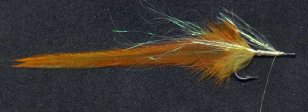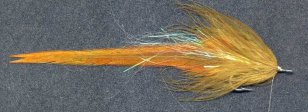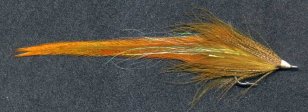
Sand eels (or sand lances) are found throughout the northeast and are a favorite food for stripers. In nature, the length and color of these slender baitfish vary widely, from 1" long up to about 14" in some places, with colors ranging from an almost cream color to olive-brown to purplish-black. Olive tones, however, predominate. It's wise, then, to have an assortment of sand eel imitations tied up in the sizes and colors that are found in the water you fish.
One of my favorite sand eel imitations is the Soft Hackle Sand Eel, an extension and simple variation of the Soft Hackle Streamer (the Fly of the Month for February, 2001). This lively imitation, when tied and fished properly, will get you into a lot of fish whenever and wherever sand eels are found. It's important to remember that the sand eel is a very slender baitfish and, therefore, your imitations should be tied rather slender as well.
Tying the Soft Hackle Sand Eel
|
Hook: |
M34007, M34001, sizes 4 - 1/0 |
|
Thread: |
6/0, white or light olive |
|
Tail Wing: |
One matched set of narrow saddle hackles with tips removed, length to vary |
|
Side Flash: |
Optional. Sparse strands of Pearl Flashabou, Glimmer, or GSS |
|
Body: |
Pearl Glimmer |
|
Hackle: |
Blood marabou feather wound around shank as hackle (sparse, with one or two turns only) |
|
Collar: |
Barred (and dyed) mallard flank, wound as collar and folded back over marabou |
Eyes: |
Black on yellow (fabric paint) |
 Match two narrow saddles hackles and remove the tips (so that you have "notched" ends, to match the shape of the tail of the natural. Tie in at bend of hook and trim excess.
Match two narrow saddles hackles and remove the tips (so that you have "notched" ends, to match the shape of the tail of the natural. Tie in at bend of hook and trim excess.
 Tie in side flash, if desired.
Tie in side flash, if desired.
Tie in five or six strands of Glimmer (tinsel may be substituted) and wind forward to form body (Be sure to allow plenty of room for a long and slender head). Trim excess (or tie excess Glimmer back and over body and then trim so that you have some "internal" flash).
 Choose a blood marabou feather of sufficient length to flow approximately 1/3 back over tailwing. With your scissors, cut the stem of this feather at a point where the stem tapers sharply from thick to thin. Discard the thick butt section and tie the marabou feather in at what is now the butt. Wind feather around shank once or twice, tie off, and trim excess.
Choose a blood marabou feather of sufficient length to flow approximately 1/3 back over tailwing. With your scissors, cut the stem of this feather at a point where the stem tapers sharply from thick to thin. Discard the thick butt section and tie the marabou feather in at what is now the butt. Wind feather around shank once or twice, tie off, and trim excess.
 Tie in mallard flank feather (where stem tapers from thick to thin) just in front of collar. Trim excess and wind and fold the mallard feather as you wind so that fibers flow smoothly back over marabou. Tie down and then trim excess. Form neat and tapered slender head. If desired, paint eyes on your head area and coat with cement (I prefer to coat the thread first, then paint eyes, then add another coat of cement when the eyes are dried).
Tie in mallard flank feather (where stem tapers from thick to thin) just in front of collar. Trim excess and wind and fold the mallard feather as you wind so that fibers flow smoothly back over marabou. Tie down and then trim excess. Form neat and tapered slender head. If desired, paint eyes on your head area and coat with cement (I prefer to coat the thread first, then paint eyes, then add another coat of cement when the eyes are dried).






